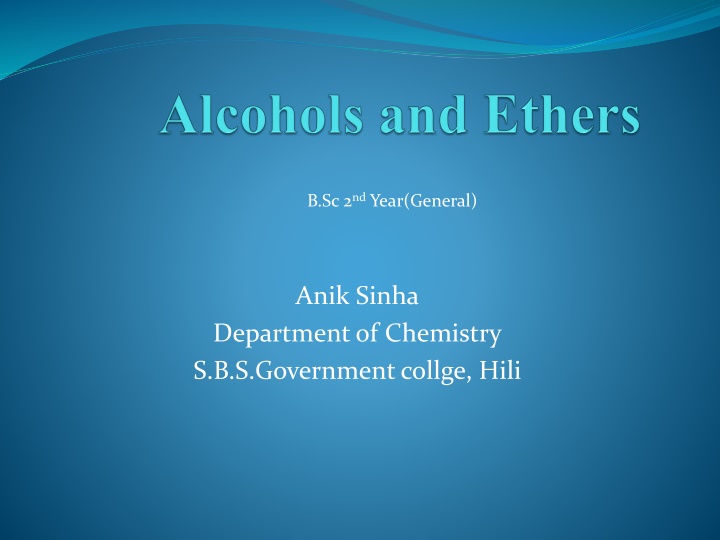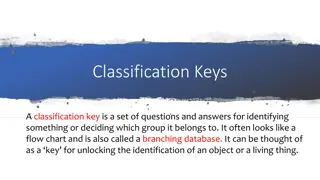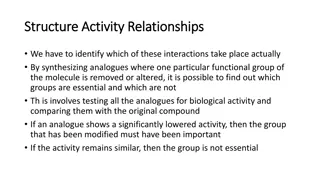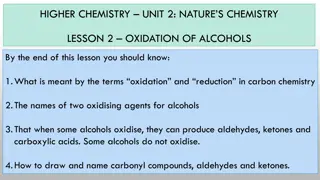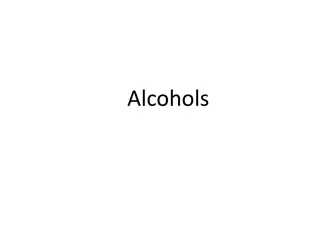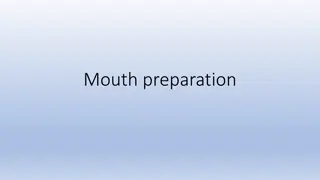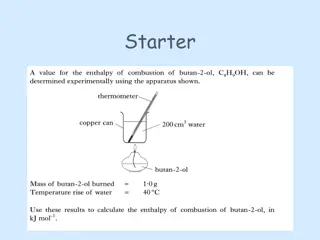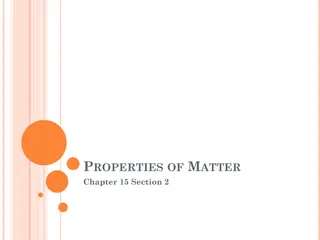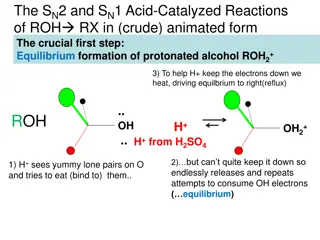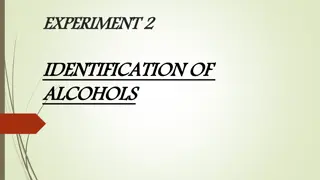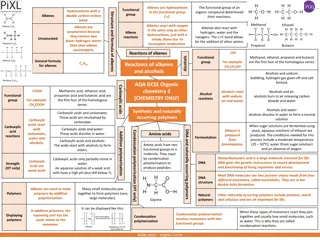Overview of Alcohols: Classification, Preparation, and Properties
Alcohols are compounds containing hydroxyl groups, classified based on chain type and number of hydroxyl groups. They can be aliphatic or aromatic, monohydric or polyhydric. Classification also includes primary, secondary, and tertiary alcohols based on carbon hybridization with the hydroxyl group. Different methods like Victor-Meyer test can identify their types. Understanding alcohol properties and reactions is essential in the study of chemistry.
Download Presentation

Please find below an Image/Link to download the presentation.
The content on the website is provided AS IS for your information and personal use only. It may not be sold, licensed, or shared on other websites without obtaining consent from the author.If you encounter any issues during the download, it is possible that the publisher has removed the file from their server.
You are allowed to download the files provided on this website for personal or commercial use, subject to the condition that they are used lawfully. All files are the property of their respective owners.
The content on the website is provided AS IS for your information and personal use only. It may not be sold, licensed, or shared on other websites without obtaining consent from the author.
E N D
Presentation Transcript
B.Sc 2nd Year(General) Anik Sinha Department of Chemistry S.B.S.Governmentcollge, Hili
Overview Definition of alcohol. Classification of alcohols. Preparations of alcohols. Reactions of alcohols. Preparations of Ethers Properties of Ethers. Reference.
Definition of Alcohol: An alcohol is a compound that contains one or more hydroxyl groups, i.e., alcohols are hydroxy derivatives of alkanes. Classifications of alcohols On the basis of type of chain Aliphatic alcohols: When the hydroxyl group (-OH group) of an alcohol is attached to an aliphatic carbon chain (open chain), the alcohol is called an aliphatic alcohol. CH3 H C H C CH3 OH OH Example: CH3OH (Methanol) Butane-2,3-diol Aromatic alcohols:When the hydroxyl group is attached to the carbon chain which is attached to an aromatic ring, the alcohol is known as aromatic alcohol. H2 C H2C OH H2C OH Example: Phenyl Methanol 2-Phenyl Methanol
On the basis of number of hydroxyl groups present Monohydric, dihydric, trihydric and polyhydric alcohols and Phenols contain 1, 2, 3 and more than three hydroxyl group respectively. H C H C H C H C H2 C H2 C H C CH3 H2C CH2 H2 C HO OH H2 C HO OH OH OH OH OH OH OH OH OH Monohydric Dihydric Trihydric Polyhydric Alcohol Alcohol Alcohol Alcohol OH OH OH OH OH OH OH OH OH OH OH OH Monohydric Dihydric Trihydric Polyhydric Phenol Phenol Phenol Phenol
On the basis the hybridization of the carbon attached with hydroxyl group (i) CSp3-OH bonded alcohols: (a) Primary (10),Secondary (20),tertiary (30) alcohols: If the hydroxyl group is attached to a primary carbon, it is called primary alcohol. Similarly, secondary and tertiary alcohols are attached to secondary and tertiary carbons respectively. CH3 CH3 H C CH3 OH C H OH C H3C OH CH3 CH3 H Primary (10) Secondary (20) tertiary (30) alcohol alcohol alcohol (b)Allylic alcohol: In theses type of alcohols OH groups are attached with allylic carbon atom. H2 C C H Allylic group CH2 OH Sp2 Sp2 Sp3
(c) Benzylic alcohol: In theses alcohol OH group attached with Benzylic group. (Sp3) H2C OH (ii) CSp2-OH bonded alcohols:In theses type of alcohols OH groups are attached with doubly bonded carbon atom. Theses are called Vinyl alcohols. H Vinyl alcohols C C H OH H Identification of primary, secondary, tertiary alcohol by Victor-Meyar method No reaction with alkali Gives blood red colour with alkali Gives blue colour with alkali
Lucas Method for identification of alcohols No turbidity appears Primary alcohol Turbidity appears after 5 minutes Secondary alcohol Turbidity appears instantly Tertiary alcohol Mixture of Anhydrous ZnCl2 and HCl called Lewis Reagent.
Preparation of Alcohols 1. From Haloalkanes: 2.From Alkenes: Ease of preparation is tert>Sec>prim. This method is best for the preparation of secondary alcohols. 3.By Hydroboration-Oxidation:
4.Oxymercuration-Demercuration of Alkenes: 5. From Carbonyl compounds: H2/Ni R-CHO RCH2OH or Pt or Pd Na/C2H5OH R-CHO RCH2OH NaBH4 LiAlH4 R-CHO RCH2OH
6. From carboxylic acid: LiAlH4/Ether R-COOH RCH2OH H3O+ 7.From Ester: Na/C2H5OH Bouveault Blanc reduction R-COO R RCH2OH+R OH Na/C2H5OH CH3COOCH3CH3CH2OH+CH3OH 8.From Grignard reagent: Grignard react with epoxides to yield primary alcohols containing more carbon atoms Reagents (i) two or aldehyde With Grignard regent gives Secondary alcohol. (ii)
Ketones, With Grignard reagents gives alcohols (iii ) tertiary Properties of Alcohols 1. Smell and Order: The lower members are liquids and have a distinctive smell where higher members are solids and almost odorless. 2. Boiling Points: Because of hydrogen bonding, alcohols tend to have higher boiling points than comparable hydrocarbons and ethers of similar molecular weight. H-bonding In Ethanol For example, the boiling point of butyl alcohol is 118 C whereas the boiling point of the isomeric diethyl ether is 36 C.
3.Solublity: Alcohols with shorter carbon chains are usually more soluble than those with longer carbon chains because the increasing size of the non polar chain disrupts the hydrogen bonding network. That is why alcohols are much more soluble in water than their corresponding alkanes, aromatic hydrocarbons, alkyl halides or aryl halides. Among isomeric alcohols, the solubility increases with branching. CH3CH2OH Soluble in Water CH3CH2CH2CH2CH2CH2CH2CH2OH Insoluble in Water Home Task: Compare the boiling points among isomeric alcohols? B.P 1180C 1080C 830C M.Wt 74 74 74 4.Viscosity: Viscosity of small alcohols are much higher than the viscosity of alkanes. 5.Density: Generally alcohols are lighter than water, i.e., less dense than water. Density of alcohols increases with molecular mass.
Chemical reactions of alcohols 1. Acylation of alcohols: When alcohol reacts with acyl halide and anhydride substitution of hydrogen atom by acyl group is known as acylation of alcohols. 2. Dehydration: Alcohols undergo dehydration to form unsaturated hydrocarbon on treating with a protic acid e.g., con. H2SO4or H3PO4, or catalysts such as anhydrous ZnCl2or Al2O3. In this reaction the OH and an H groups removes from an adjacent carbons. Since water is removed from the alcohol, this reaction is known as a dehydration reaction. Mechanism For primary alcohols, the conditions required conc. sulphuric acid and temperature of 1700C. are
Secondary alcohols dehydrate under milder conditions than primary alcohols. Tertiary under even milder conditions. alcohols dehydrate The main function of the acid is to transform the poor leaving group OH into the very good leaving group -OH2. The order of the relative ease of dehydration of alcohols is: 30>20>10 Dehydration of secondary and tertiary alcohols containing more than three carbon atoms will give a mixture of alkenes, the major product can be determined from Saytzeff s rule. Saytzeff s rule: When an alkene is produced elimination the major product is the one with the more highly double bond . in reaction, an substituted
3.Halogenation: Alcohols can be converted to alkyl halides using one of three reactions. Reactions with Hydrogen Halide. Reaction with thionyl chloride Reactions with phosphorous halides 4.Iodoform Reaction: When Iodine and sodium hydroxide are added to alcohol that contain CH3CH(OH)- Group a pale yellow precipitate of iodoform or tri iodomethane is formed. This is called iodoform reactions of alcohol. Ethanol is the only primary alcohol that gives iodoform test.
Home Task: Differenciate with chemical reaction: 1. Ethanol and Methanol 2. 1-Propanol and 2-Propanol 3. 1-Phenyl Ethanol and 2-Phenyl Ethanol 5.Esterification of alcohol: Conversion: Conversion alcohol to lower alcohol Ethanol Methanol of Higher Conversion alcohol to Higher alcohol Methanol Ethanol of Lower
Ethers Preparations of Ethers 1.By Dehydration of Alcohols: N.B. at higher temperature alkene are formed instead of Ether. 2.By alkyl Halides: 2 AgBr 2 AgBr 3.Williamson synthesis of ethers: This method involves treatment of an alkyl halide with sodium or potassium salt of alcohol or phenol. This reaction involves a nucleophilic substitution of halide ion by alkoxide ion(SN2 mechanism).
(SN2 mechanism) If a tertiary alkyl halide is used ,an alkene is the only reaction product because alkoxide then act as a strong base and elimination favours substitution. over 4. From Acyl chloride: Friedel-Craft Reaction
5.From Grignard reagent: Properties of Ether (i) Physical state: The lower members are gases or volatile liquids and their vapours are highly inflammable (ii) Boiling points: Boiling points of ethers are much less than isomeric alcohols due to the absence of H-bonding. (iii) Solubility: All ethers are less dence than water in which they are not very soluble but solubility increased with adding alcohol due to the formation of H- bond. Chemical reactions of Ethers 1. Reactions with Lewis acid: Being Lewis base ethers forms complexes lewis acid which are called Etherates. with
2. Action of Hydroiodic acid: (a) With cold HI: + (b) With Hot HI: 3. Action of PCl5: 4. Dehydration:
Reference 1.Organic Chemistry by I.L.Finar 2.Organic Chemistry by Morrison and Boyd. 3.Advance organic chemistry by bahl & bahl. 4.Organic Chemistry by Brucee. 5.Organic chemistry by R.L.Madan 6.A Guidebook to mechanism in Organic chemistry by P.sykes. 7.Wikipidea.
Thank You
